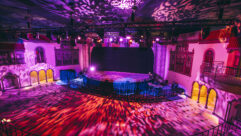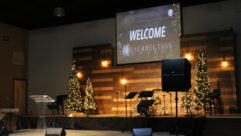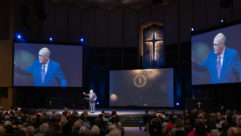Cinema Sanctuary
Aug 1, 2000 12:00 PM,
Gegory A. DeTogne
It was, at one point in time, a rather bleak interior landscape. A place,by all appearances, best suited for storing outdated kitchen appliances,forgotten articles of clothing and other obsolete artifacts of suburbanlife. Blistering hot in the summer and cold in the winter, it was notunlike any other modern attic with its roughed-in drywall, bare light bulbsand occasional spider web.
There was one man, however, who looked into this neglected space above afour-car garage in an upscale Dallas suburb and saw more. Within hisvision, a calming personal oasis materialized, a retreat for the body andspirit where he could relax at the end of his day’s work, indulge hispassions for cinema, watch sporting events or simply hang out and see whatLeno was up to after the news.
Ultimately, the day came not that long ago when this man’s home theaterdream began to evolve into a reality with the look, feel and textures of aclassic movie palace from the 1930s outfitted with electronic systems ofthe new millennium. In making this architectural and technologicaltransition, this man and his spouse enlisted the talents of twoDallas-based firms – Electronic Interiors and Paramount Entertainment.
A full-service systems integration firm, Electronic Interiors was foundedfour years ago by David Dodson. During the course of building his company,Dodson kept running into a local architect and interior designer named MarkKlinger, who worked for a commercial theater design company calledCinemark. Klinger, a specialist in creating high-end screening rooms forexecutives and other VIPs around town and beyond, eventually found himselfengaging in dialog with Dodson, which led to the pair’s creating ParamountEntertainment, a design business dedicated solely to the development andimplementation of home-theater environments.
After analyzing the space and the clients’ needs on a number of levels,Paramount studied a blueprint conceived at an earlier date for the proposedcinematic redoubt, then drew up new plans. Inspired as much by the presenceof the proposed electronic systems as aesthetic considerations, the designwas handed over to Electronic Interiors, which, in a departure fromstandard industry procedures, served as the general contractor on the jobas well as the entity responsible for systems integration.
“Working in tandem with Paramount Entertainment, we can offer the ultimatein true turnkey installation services,” Dodson said. “Everything can bemanaged from the conceptual architectural stage on through systems designand installation. On this project, we also took the extra step of servingas the general contractor. That move gave us total control over the actualconstruction as well, and saved the client from the burden of dealing withadditional service providers.”
Operating in his capacity as general contractor, Dodson recruited thecarpentry skills of Homes by Bowen, another Dallas firm, to begin thestructural transformation of the barren, sheetrocked attic into a cinematicshowplace. While the sound of banging hammers and power tools reverberatedthrough the garage end of the residence, Dodson took stock of the intendedelectronic systems that would be put into place. Featuring a pair of ZenithPro900 HDTV-ready digital projectors aiming at a sprawling Stewart SN135-HDmicro-perforated screen, B&K amplification and processing, Lutron lightingand surround sound components from the PSB Silver Stratus line, the room’sA-V dimensions were approved by the owner with the strict stipulation thatcontrol for the sophisticated hardware be kept simple.
“From the very outset of the project, the owner emphatically expressed adesire to make the theater easy to use,” said Dodson. “He didn’t want totake a course on how to run things nor be forced to read a stack ofmanuals. The operation of the room had to be so simple that you couldmanage every aspect of it without a second thought. I definitely can relateto his request from a user’s standpoint and will second the motion from acontractor’s point of view. Theater environments are generally the mosttechnically advanced rooms in any integrated home. To design and installone without a centralized form of complete system control is just askingfor trouble. Trouble on my end means regular service calls, many of whichwill most assuredly arrive at 10 P.M. on weekends and holidays.”
It was against this philosophical backdrop that Electronic Interiorsembraced an A-V agenda based around a SmarTouch STS-C wireless controlsystem from Crestron Electronics. A complete RF-based, networking devicecompatible with virtually any electronic component, the STS-C systemconsists of an ST-CP control processor and an ST-1550C color LCD touchpanelwith a screen resolution of 320 infinity 240 pixels that can easily becarried about in one hand. Programmed by Dodson using a drag-and-dropWindows-based program, the Crestron system provides one-touch management ofa host of different functions spanning systems in all corners of the roomfrom lighting, audio and video to the movements of a motorized curtain forthe screen. Because the touchpanel issues commands via RF as opposed towithin the infrared spectrum, line-of-sight issues were eliminated, therebyproviding the owner with more freedom of movement and even the ability tocontrol components through walls and mounted inside closed cabinetry.
“With the owner’s input, I wrote a comprehensive program for the SmarTouchsystem which basically makes the wireless color touchpanel as easy to useas a regular telephone and a lot easier to use than a microwave,” Dodsonsaid. “The system is so simple that everyone in the house took to itimmediately, even the children. And most importantly, this home’s controlnetwork, just like others we’ve created like it elsewhere, has just abouteliminated control-oriented service calls. Overall, in fact, since we’vestarted using centralized forms of control like this instead of traditionalremotes, our service department has reported that trouble calls have gonedown 60%.”
There are two tiers of seating in the theater consisting of threeupholstered, reclining chairs on a lower level and five on the top.Typically, the controlling touchpanel sits next to a rear seat regularlyoccupied by the owner. From this vantage point or anywhere else, thetouchpanel’s opening screen can be accessed to reveal a pair of buttons -one marked “Showtime Movie,” and another marked “Showtime TV.” With asimple touch, the onscreen “Showtime Movie” button, as its name implies,leads the user to a list of all the cinematic sources offered, which as ofthis writing, include a Toshiba SD-3108 DVD player and a Toshiba M762 hi-fiVCR. Press one of these selections, and another screen materializesdisplaying transport functions for either piece of gear. Not in the moodfor a movie? Press “Showtime TV,” and you can select from a multitude ofchannels arriving on the scene courtesy of an RCA DSS satellite system,which also feeds display sources in other areas of the house.
Beyond placing great concern upon ease-of-use issues and a form ofreliable, centralized control, which works seamlessly with all thecomponents involved, the owner additionally asked that Electronic Interiorsprovide the theater with the brightest picture possible. To that end,Dodson specified the aforementioned pair of Zenith Pro900 digitalprojectors instead of just one, each of which receives signals from aFaroudja VP-250 line doubler. Mounted side-by-side from the ceiling in acustom-made soundproof enclosure, output imagery from the stationaryprojectors was converged one on top of the other according to grayscale andcolor saturation calibration standards established by the Imaging ScienceFoundation (ISF).
Measuring 135 inches (3.4 m) diagonally, the Stewart micro-perforated filmscreen is automatically hidden from view by motorized velvet curtains whennot in use. Burgundy in color, the curtains complement the rich,period-authentic opulence of the rest of the room and open and close aspart of scenes stored within the Crestron network governing functionsrequired to power the theatre up or down. This time using THX guidelines,Electronic Interiors calculated the size of the Stewart screen based uponthe room’s viewing angles so that each seat envelops the viewer’speripheral vision to an extent experienced in full-scale commercialtheaters.
The B&K components within the audio signal path include a three-channelmodel TX4430 200 W amp that fuels the left-center-right PSB Silver Stratusloudspeakers located behind the filmscreen. Each outfitted with a pair of6.5 inch (165 mm) low/mid transducers and a single 1 inch (25.4 mm)aluminum dome tweeter, the two-way PSB L-C-R cabinets are joined by PSBtwo-way Mini-Stratus surrounds powered by a 200 W B&K EX4420 two-channelamp. At the bottom of scheduled sound reinforcement events, ground-shakingbass response makes itself felt via a PSB Subsonic III subwoofer alsostashed out-of-sight behind the filmscreen.
Audio processing lies within the B&K realm as well, with a model AVP-4090unit residing at hand capable of translating Dolby Digital, DTS, DVD andPro Logic formats into a truly hi-fi experience. On the equalization sideof things, an Audio Control Bijou Theatre Series EQ unit steps into thefray to help maintain a flat response across the entire audible spectrum.
While designing the room, David Dodson and partner Mark Klinger gave nosmall amount of attention to the matter of acoustics. “You can put ahideously expensive audio system into a bad room, and it still won’t soundgood,” Dodson said by way of explaining the extra effort that he andKlinger expended in analyzing the theater’s acoustics. “Conversely, a goodroom can only bring out the best in your electronics.”
The acoustical challenge in this one-time attic space was to maintainaesthetics while balancing just the right amounts of the room’s absorptiveand reflective qualities. For our designing duo, striking this balancemeant killing off first reflections from the walls and floor withabsorptive panels and thick carpeting from Fabrica and then applying a hardsurface at the rear to diffuse matters. Reverberation times, in turn, werehandled as a percentage of absorption to diffusion.
“You want the rear of the theater to be live and slightly excitable toembellish the surround field,” Dodson said. “The front of the room shouldessentially be dead.”
Once again falling under the guiding aegis of the Crestron network,lighting functions in the theater are directed from a Lutron GRX-3106TGrafik Eye system. A six-zone theme controller by definition, the GrafikEye was used in this application to store four different scenes rangingfrom total black for screenings to various stages of lowered lighting and afull-on setting for clean-up.
Taking approximately 12 months from its basic inception through the designphase and onward toward final completion, the project wrapped-up as thecalendar reached January of this year. Although limited in some respects bythe size and shape of the space, which could not be altered, Dodson ishappy to report that there were really no problems that could not be solvedalong the road to providing the client with an optimally performingenvironment.
“Everything wound up being calibrated perfectly,” he said with a satisfiedgrin. “The audio intelligibility is excellent, as are the screeningcapabilities, and the whole thing is so easy to use and control that wecan’t believe it ourselves. As for the owner, you can’t get him out of theplace. He even reads in there. Now that certainly says a lot for thephysical comforts of a room dedicated to moving pictures.”










